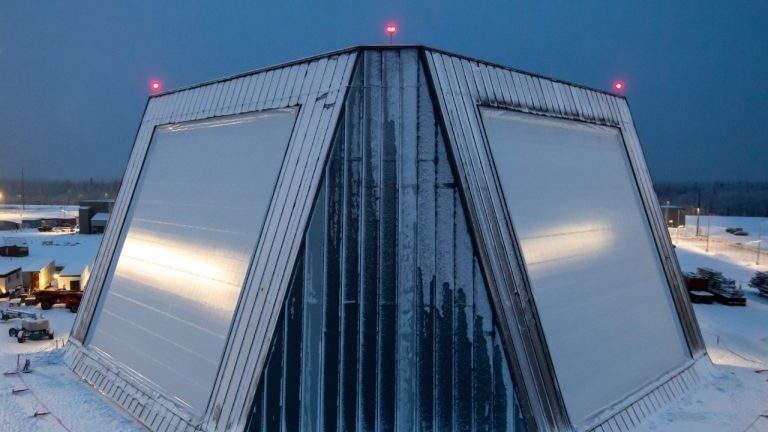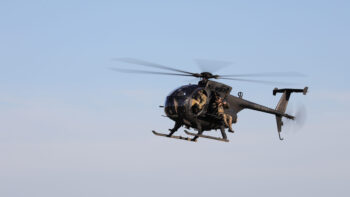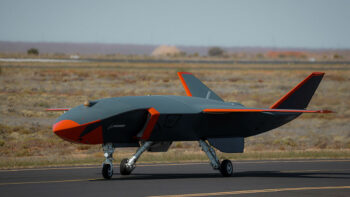
Long Range Discrimination Radar (LRDR) is being tested by the Missile Defense Agency at the Clear Space Force Station in Alaska. (Photo: Missile Defense Agency)
SMD SYMPOSIUM — What’s the best way to take out a highly maneuverable, hypersonic missile that bounces off the atmosphere and screams towards its terrestrial targets? In the view of a senior military official here, just take the thing out before it even launches, of course.
Rear Adm. Sean Regan, NORTHCOM director of operations, told the annual Space and Missile Defense (SMD) Symposium in Huntsville, Ala., today that rather than only trying to knock a missile out of the sky, his command’s new strategy for future defense of the homeland leans heavily on emerging technologies and capabilities, including directed energy weapons, autonomous vehicles and electronic warfare to take out adversary missiles and other threats before, or shortly after, they get off the ground.
“We know that our competitors and adversaries will continue to advance by developing emerging tech technologies and capabilities. We also know that a ‘bullet on bullet’ strategy in the future is not fiscally possible. We simply cannot afford to try to match the ever-increasing threat by kinetic means alone,” Rear Adm. Sean Regan, NORTHCOM director of operations, told the annual Space and Missile Defense (SMD) Symposium here in Huntsville, Ala., today.
“The best missile strategy is to destroy the missiles prior to launch. A focus on missile defeat could enable distributed non-kinetic systems with larger magazines and the ability to engage missiles before they can deploy complex decoys, countermeasures, maneuvers or multiple reentry vehicles,” he said. “We must get further left of launch in our approach. Integrated deterrence is establishing competition by using all levers of influence integrated across all domains and globally.”
Regan noted, in particular, emerging threats from hypersonic missiles like those used by Russia in Ukraine, Chinese high-altitude balloons and North Korea’s development of solid fuel rockets.
“We know that the homeland is no longer a sanctuary. Our strategic nuclear deterrence is the foundation of homeland defense. But we must also account for the conventional capabilities our contenders have fielded or are developing,” he said.
To get on top of those rapidly changing threats, Regan said, NORTHCOM and NORAD have “developed our own defense ‘design’ for 2035, which outlines new ways and means for defending the homeland. This is very different from what we do today.”
The commands’ focus “going forward relies less on kinetic engagement, instead emphasizing non-kinetic means … such as directed energy, electronic attack, high power microwaves, to complement our direct kinetic active defenses.”
Regan said that the new NORTHCOM strategy pivots to “missile defeat” via systems for targeting adversary launch complexes prior to launch, and away from its traditional focus on “missile defense.”
It also covers all stages of a conflict, and integrates air and missile defenses much more tightly than in the past, Regan explained.
This includes the future use of “autonomous maritime and airborne platforms” to conduct early domain awareness, coupled with artificial intelligence tools to allow rapid digestion and dissemination of the incoming data and speed decision-making.
Improved domain awareness, he stressed, remains the top priority of NORTHCOM/NORAD Commander Gen. Glen VanHerck. In the near term, a key system will be the Long Range Discrimination Radar (LRDR).
That S-band radar’s primary purpose is to distinguish between intercontinental ballistic missiles launched by adversarial nations towards the US and decoys or other innocuous objects moving through space. In addition to protecting the country from a legitimate attack, the capability to differentiate between real threats and decoys helps to preserve the Pentagon’s precious supply of interceptors. It also is designed to keep better tabs on jinking hypersonic missiles.
Regan said that NORTHCOM is now hopeful that the Missile Defense Agency (MDA) will be able to connect the LRDR to the “operational architecture” in 2024. (NORTHCOM last summer had been predicting that move to happen by the end of 2022, and the Government Accountability Office this May chided MDA for failing to meet its LRDR testing goals last year.)
Rear Adm. Doug Williams, new acting director of MDA, told the SMD Symposium in a later presentation that the LRDR, based in Clear, Alaska, will be operationally tested on Aug. 16 in an exercise involving the launch of a target intercontinental ballistic missile.






















